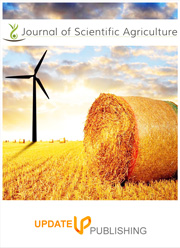Performance evaluation of improved mung bean (Vigna radiata (L.) Wilczek) varieties at low moisture areas East Shewa, Oromia, Ethiopia
DOI:
https://doi.org/10.25081/jsa.2022.v6.7289Keywords:
Mungbean, grain yield, VarietiesAbstract
Mung bean is a useful crop in drier areas and has a good potential for crop rotation and relay cropping with cereals using residual moisture. The experiment was conducted at Adami Tulu Agricultural Research Center (ATARC), Lume and Dugda during 2018 and 2019 with the objective to identify adaptable and high yielder mung bean varieties for East Shewa Zone and similar agro ecologies. Four released mung bean varieties Shewa robit, Beroda, N-26 and Arkebe used as planting material. The experiment was laid down in Randomized Complete Block Design (RCBD) with three replications. The plot size was 1.8m × 2.5 m (4.5 m2) having 6 rows and a spacing of 0.30 m between rows and 50 cm between replication, 1 m between blocks. Data’s like height (cm), number of pods per plant, number of seeds per pod, days to days to flowering, days to maturity, grain yield (kg ha-1), 100 seed weight (g) were collected and analyzed using SAS software. The combined analysis of variance showed that there was significant variation at (P≤0.05 and P≤0.01) among the studied varieties, locations, and year main effect. There were also significant interaction effect on location by year, varieties by year and location by varieties by year for grain yield and other yield components. But non-significant on varieties by location for all traits except plant height and indicated those varieties were performed similarly across the locations. Shewa Robit variety had a higher grain yield (1607.4 kg ha-1) followed by N-26 (1542 kg ha-1) and Beroda (1466.1 kg ha-1). While Arkebe Variety had a lower grain yield (893.4 kg ha-1) as compared with other varieties. Therefore Shewa Robit and N-26 were recommended for the study area and similar agro-ecologies.
Downloads
References
Ahmad, S., Khan, A. A., Ali, S., Imran, M., & Habibullah, M. (2015). Impact of phosphorus levels on yield and yield attributes of Mungbean cultivars under Peshawar valley conditions. Journal of Environment and Earth Science, 5(1), 18-25.
Asrate, A., Gurum, F., Alemayehu, F., & Rezene, Y. (2012). Analysis of Multi-environment Grain YieldTrials in Mung Bean Vigna radiate (L.) Wilczek Basedon GGE Bipot in Southern Ethiopia. Journal of Agricultural Science and Technology, 14(2), 389-398.
ECX (Ethiopian Commodity Exchange). (2014). Ethiopian commodity exchange rings bell for Mung Bean, January 23, 2014 Addis Ababa, Ethiopia.
EPP (Ethiopian Pulses Profile). (2004). Ethiopian export promotion agency, product development & market research directorate, May 2004 Addis Ababa, Ethiopia,
Keatinge, J. D. H., Easdown, W., Yang, R., Chadha, M. L., & Shanmugasundaram, S. (2011). Overcoming chronic malnutrition in a future warming world: The key importance of mungbean and vegetable soybean. Euphytica, 180(1), 129-141. https://doi.org/10.1007/s10681-011-0401-6
Mequannit, A., & Tefera, A. (2020). Adaptation study of mung bean (Vigna radiata) varieties in Tepi, South Westen Ethiopia. Asian Journal of Plant Science and Research, 10(5), 58-61.
Omid, S. (2008). Effect of withholding irrigation at different growth stages on yield and yield components of mung bean Vigna radiate L. Wilczek) varieties. American-Eurasian Journal of Agricultural and Environmental Sciences, 4(5), 590-594.
Polhill, R. M., & vander Maesen, L. J. G. (1985). Taxonomy of grain legumes, In R. J. Summerfield, & E. H. Roberts (Eds.), Grain Legume Crops (pp. 3-36).
Rasul, F., Cheema, M., Sattar, A., & Saleem, M. F. (2012). Evaluating the performance of three Mung bean varieties grown under varying inter-row spacing. Journal of Animal & Plant Sciences, 22(4), 1030-1035.
Wedajo, G. (2015). Adaptation study of improved mung bean (Vigna radiate) varieties at Alduba, South Omo, Ethiopia. Research Journal of Agriculture and Environmental Management, 4(8), 339-342.
Published
How to Cite
Issue
Section
Copyright (c) 2022 Temesgen Dinsa, Urgaya Balcha, Fayisa Benya, Mihratu Fufa

This work is licensed under a Creative Commons Attribution-NonCommercial-NoDerivatives 4.0 International License.



 .
.